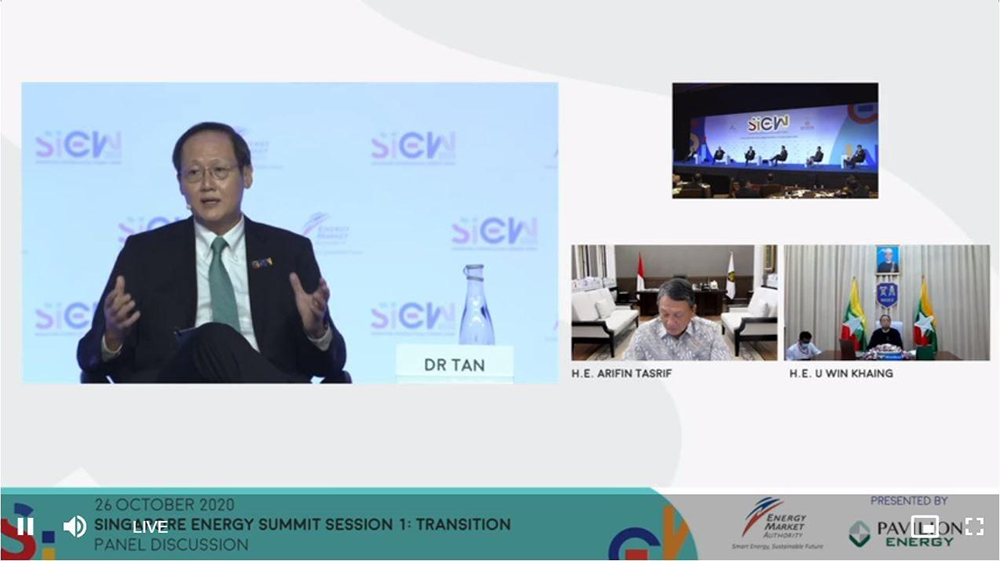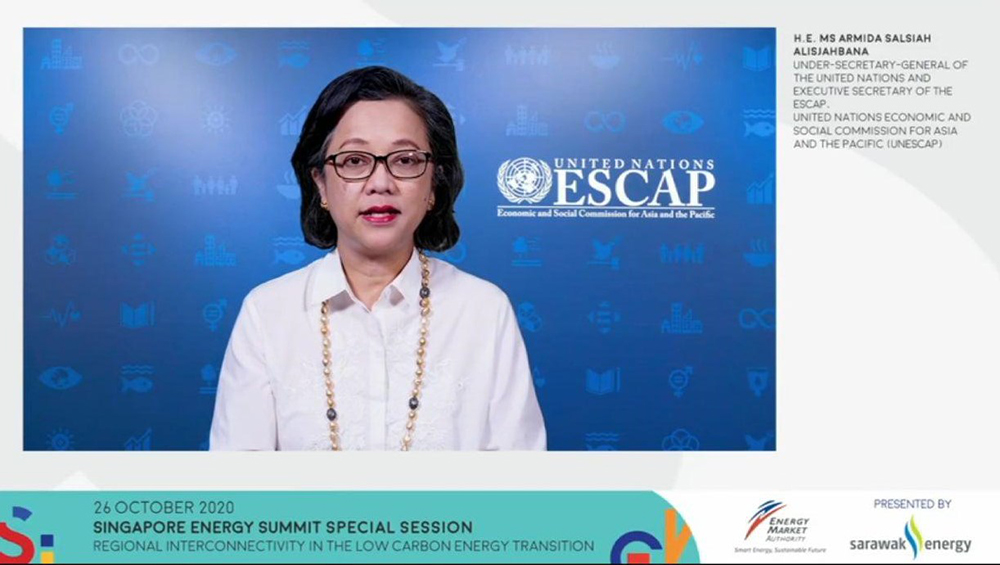Policymakers and industry thought leaders discussed what's at stake for sustainable energy transition at the first session of the Singapore Energy Summit. By Harvey Cheong

Global energy industry leaders and policy makers convened at the Singapore Energy Summit on 26 October for a wide-ranging dialogue on the collaborative efforts required to accelerate a low carbon energy future.
Transition towards low carbon energy
Dr Tan See Leng, Second Minister for Trade and Industry & Manpower of Singapore, shared that the transition towards low carbon energy comes with multiple opportunities to accelerate sustainability efforts and improve energy resilience. Governments must work closely with industry and academia to develop innovative policies and sustainable solutions.
But decarbonisation efforts cannot be limited to Singapore alone. Dr Tan noted the step-up in efforts to drive low carbon energy transition across Asia—and affirmed that Singapore’s readiness to work with regional and global counterparts towards a sustainable long-term energy future.
H.E. YB Dato Seri Setia Dr Awang Haji Mat Suny bin Haji Md Hussein, Minister of Energy, Brunei Darussalam, agreed that collaboration between governments and industry players would be needed to push the energy transition forward. He highlighted that governments must take a leading role in directing energy investment towards long-term sustainability. He added that clean fuels would be critical in balancing sustainability with regional energy needs.
Mr Frédéric H. Barnaud, Group Chief Executive Officer of Pavilion Energy, noted that the major demand, price, and supply shocks throughout energy markets due to the COVID-19 pandemic suggest that the energy transition is more urgent now than ever before. He urged all energy players to collaborate towards the common goal of recovering in a sustainable way as well as stimulating an accelerated path towards net-zero carbon energy use.

How might Asia Pacific countries transition to low carbon energy?
During the panel discussion, speakers exchanged views on how the low carbon energy transition could take shape in Asia Pacific.
First, changes in the energy mix is critical. Minister of Energy and Mineral Resources of Indonesia, H.E. Arifin Tasrif, shared that Indonesia is currently building its first floating solar deployment, while H.E. U Win Khaing, the Minister of Electricity and Energy of Myanmar, said that a key part of Myanmar’s decarbonisation plan is to increase the use of LNG in the energy mix.
Second, the need for increased government and industry collaboration. Dr Tan, Second Minister for Trade & Industry and Manpower of Singapore, cited the floating solar farm at Tengeh Reservoir as an example of how collaboration between government agencies, industry, and academia could help in the transition.
Third, industry initiatives. Jimmy Khoo, Chief Executive Officer of SP Power Grid Limited, suggested that industry initiatives such as control system digitalisation could also assist in the transition.
Paul Maguire, President and Regional Chief Executive Officer of ENGIE Asia Pacific, added that virtual power plant technology would also allow power grids to fully realise the benefits of energy generating devices and improve energy sustainability.
On the other hand, Aw Kah Peng, Chairman of Shell Companies in Singapore, cited the introduction of more electric vehicle charging points as an example of how customers could be brought along with a company’s transformation towards greater sustainability.
When asked about his views on Asia's energy landscape, Toshiro Kudama, Chief Executive Officer of JERA Asia, commented that the region must address its energy needs with different approaches—and a strong focus on reducing CO2 emissions while ensuring economic rationality. He added that while renewables will prevail over the long term, clean energy sources such as LNG will still play a pivotal role in the region's energy transition.
Mr Kudama also highlighted JERA's roadmap for achieving zero CO2 emissions by 2050 as an example of the low carbon transformation that is taking shape, such as utilising existing carbon-intensive assets to support new innovations in hydrogen and ammonia.
Role of regional interconnectivity in low carbon transition
H.E. Armida Salsiah Alisjahbana, Executive Secretary, United Nations Economic and Social Commission for Asia and the Pacific (UNESCAP), started the Special Session on regional interconnectivity with her remarks.

She noted that the COVID-19 pandemic served as a reminder for countries in Asia Pacific to steer towards sustainable energy transition and transform from grey economies to green economies. She suggested that electrical interconnectivity across countries, when properly guided, could help rapidly increase the share of renewable energy in a country’s energy mix in a sustainable and resilient way.
James Ung, Chief Executive Officer of Sarawak Energy Berhad (SEB) Power, noted that regional connectivity strengthens the resilience and security of energy systems through the sharing of generation capacity.
Echoing these sentiments, Dr Akhomdeth Vongsay, the Director General of the Department of Planning and Cooperation from the Laos Ministry of Energy and Mines, added that connectivity would be crucial in building a more sustainable and resilient energy future.
As an example of how interconnected energy systems could drive sustainable energy transition, H.E. Dr Ith Praing, Secretary of State of the Ministry of Mines and Energy of Cambodia, highlighted Cambodia’s interconnected energy grid with Laos, Thailand, and Vietnam.
Follow us on Twitter (@SIEW_sg) to get the latest #SIEW2020 updates throughout the day!